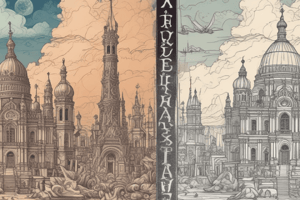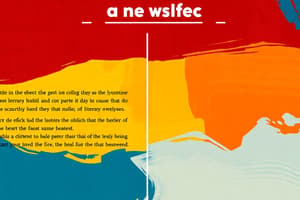Podcast
Questions and Answers
Which of the following signal words or phrases would most likely indicate a compare and contrast text structure?
Which of the following signal words or phrases would most likely indicate a compare and contrast text structure?
- Consequently, therefore, as a result
- In order to, to solve, the issue
- Although, however, as well as (correct)
- First, second, third
An informational text details the life cycle of a butterfly, starting from an egg to a caterpillar, then a pupa, and finally a butterfly. Which text structure is being utilized?
An informational text details the life cycle of a butterfly, starting from an egg to a caterpillar, then a pupa, and finally a butterfly. Which text structure is being utilized?
- Descriptive
- Compare and contrast
- Chronological order (correct)
- Problem and solution
In an informational text, an author presents the declining population of bees, then discusses the causes of this decline, and finally proposes several strategies to reverse this trend. Which text structure is the author using?
In an informational text, an author presents the declining population of bees, then discusses the causes of this decline, and finally proposes several strategies to reverse this trend. Which text structure is the author using?
- Descriptive
- Compare and contrast
- Chronological order
- Problem and solution (correct)
How does the descriptive text structure primarily impact the reader's experience?
How does the descriptive text structure primarily impact the reader's experience?
What is the primary purpose of using chronological order in informational texts?
What is the primary purpose of using chronological order in informational texts?
Which organizational structure would be most effective for an informational text aiming to explain the consequences of deforestation on climate change?
Which organizational structure would be most effective for an informational text aiming to explain the consequences of deforestation on climate change?
An informational text describes two different approaches to renewable energy: solar power and wind power. The author details the installation process, energy output, and environmental impact of each. Which organizational structure is the author most likely using?
An informational text describes two different approaches to renewable energy: solar power and wind power. The author details the installation process, energy output, and environmental impact of each. Which organizational structure is the author most likely using?
In a passage, an author presents the declining population of bees and then discusses several potential factors contributing to this decline, such as pesticide use and habitat loss. Which organizational structure is most evident in this passage?
In a passage, an author presents the declining population of bees and then discusses several potential factors contributing to this decline, such as pesticide use and habitat loss. Which organizational structure is most evident in this passage?
An article presents information about the evolution of the smartphone, starting with the earliest models and progressing to the latest advancements. Which organizational structure is primarily employed?
An article presents information about the evolution of the smartphone, starting with the earliest models and progressing to the latest advancements. Which organizational structure is primarily employed?
A passage discusses the rising costs of college tuition and then presents several strategies students can use to manage their finances, such as applying for scholarships and working part-time. Which organizational structure is the author most likely using?
A passage discusses the rising costs of college tuition and then presents several strategies students can use to manage their finances, such as applying for scholarships and working part-time. Which organizational structure is the author most likely using?
Flashcards
Compare and Contrast
Compare and Contrast
Highlights similarities and differences between two or more subjects.
Chronological Order
Chronological Order
Presents events or actions in the order they happened.
Problem and Solution
Problem and Solution
Explains an issue and how it was resolved.
Descriptive Structure
Descriptive Structure
Signup and view all the flashcards
Compare/Contrast Keywords
Compare/Contrast Keywords
Signup and view all the flashcards
Informational Text Structure
Informational Text Structure
Signup and view all the flashcards
Cause and Effect
Cause and Effect
Signup and view all the flashcards
Study Notes
- Informational text structure is crucial for clarity and the strength of an argument.
- Authors use different structures to convey their message effectively.
- Five common structures include cause and effect, compare and contrast, chronological order, problem and solution, and description.
Cause and Effect
- Used to create a direct correlation between an event, idea, or action and its result.
- Example: A team with bad players loses to a team with good players.
- Easily identified by the author's use of background information and context to lead to a predictable result.
- The effect can be listed first with little change to the meaning.
Compare and Contrast
- Analyzes the similarities and differences between two similar ideas, people, places, or things.
- Can be used within a paragraph or as the structure of an entire text.
- Often involves laying out the first subject, then the second, followed by a comparison.
- Keywords and phrases like 'although,' 'both,' 'however,' or 'as well as' indicate a comparison.
- Example: Stephanie and Jim are both liberal, but have different beliefs about certain political issues.
Chronological Order
- Relates a series of events or actions in the order in which they occurred.
- Commonly used in history textbooks or background sections.
- Helps the reader understand the sequence of events and encourages critical thinking.
Problem and Solution
- Used to explain situations where an issue was addressed.
- The author lays out the problem before explaining how it was addressed, by whom, and the resulting solution.
- The problem and solution can be short or used as a structure for an entire essay or book.
- Example: Devin hurts his knee, goes to a doctor, and undergoes physical therapy after being diagnosed.
Descriptive
- Helps make the situation or concepts being explained more dynamic for the reader.
- By describing a scenario or an idea creatively, descriptive passages can make a concept really come alive for the reader.
- Aids in illustrating an event, idea, or situation for a reader who may not find statistics and facts compelling.
- Example: Describing a WWI battlefield to illustrate the impact of the war on young soldiers.
Studying That Suits You
Use AI to generate personalized quizzes and flashcards to suit your learning preferences.




